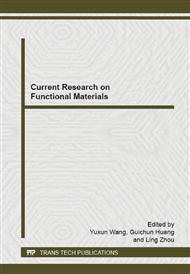[1]
Amar M. Khudhair, Mohammed M. Farid, A review on energy conservation in building applications with thermal storage by latent heat using phase change materials, Energy Conversion and Management. 45(2004) 263-275.
DOI: 10.1016/s0196-8904(03)00131-6
Google Scholar
[2]
M Hadjievaa, RStoykova, TzFilipovab, Composite salt-hydrate concrete system for building energy storage. Renewable Energy. 19 (2000) 11l-115.
DOI: 10.1016/s0960-1481(99)00024-5
Google Scholar
[3]
Paris J, Falardeau M, Villeneuve C. Thermal storage by latent heat: a viable option for energy conservation in buildings, Energy Sources. 15 (1993) 85-93.
DOI: 10.1080/00908319308909014
Google Scholar
[4]
Zhang ZG, Fang XM, Study on paraffin/expanded graphite composite phase change thermal energy storage material, Energy Conversion and Management. 47 (2006) 303-10.
DOI: 10.1016/j.enconman.2005.03.004
Google Scholar
[5]
Karaipekli A, Sari A, Kaygusuz K, Thermal conductivity improvement of stearic acid using expanded graphite and carbon fiber for energy storage applications, Renewable Energy. 32 (2007) 2201-2210.
DOI: 10.1016/j.renene.2006.11.011
Google Scholar
[6]
Marin JM, Zalba B, Cabeza LF, Mehling H. Improvement of a thermal energy storage using plates with paraffin–graphite composite, International Journal Heat Mass Transfer. 48 (2005) 2561-2570.
DOI: 10.1016/j.ijheatmasstransfer.2004.11.027
Google Scholar
[7]
Ahmet Sarl, Ali Karaipekli, Thermal conductivity and latent heat thermal energy storage characteristics of paraffin/expanded graphite composite as phase change material, Applied Thermal Engineering. 27 (2007) 1271–1277.
DOI: 10.1016/j.applthermaleng.2006.11.004
Google Scholar
[8]
Min xiao, Bo feng, Kecheng Gong, Preparation and performance of shape stabilized phase change thermal storage materials with high theral conductivity, Energy conversion and management. 43 (2002) 103-108.
DOI: 10.1016/s0196-8904(01)00010-3
Google Scholar
[9]
Belen Zalba, Review on thermal energy storage with phase change: materials, heat transfer analysis and applications. Applied Thermal Engineering, 23 (2003) 251-283.
DOI: 10.1016/s1359-4311(02)00192-8
Google Scholar
[10]
Ali Karaipekli, Ahmet Sarı, Capric–myristic acid/vermiculite composite as form-stable phase change material for thermal energy storage. Solar Energy, 83 (2009) 323-332.
DOI: 10.1016/j.solener.2008.08.012
Google Scholar
[11]
Shilei, L., Neng, Z., Guohui, F. Eutectic mixtures of capric acid and lauric acid applied in building wallboards for heat energy storage, Energy Buildings. 38 (2006) 708-711.
DOI: 10.1016/j.enbuild.2005.10.006
Google Scholar
[12]
Karaipekli, A., Sarı, A, Capric acid and palmitic acid eutectic mixture applied in building wallboard for latent heat thermal energy storage, Journal of Scientific and Industrial Research. 66 (2007) 470-476.
DOI: 10.1002/er.1352
Google Scholar
[13]
Kissock, J.K., Hanning, J.M., Whitney, T.I., Drake, M.L. Early results from testing phase change wallboard. [C]/ Proceedings of the 1st IEA ECES IA Annex 10 Workshop, Adana, Turkey, 1998, pp, 69-79.
Google Scholar
[14]
Hawes DW, Banu D, Feldman D, Latent heat storage in concrete. II, Solar Energy Materials. 21 (1990) 61-80.
DOI: 10.1016/0165-1633(90)90043-z
Google Scholar
[15]
Hawes DW, Feldman D. Absorption of phase change materials in concrete. Solar Energy Materials Solar Cells, 27 (1992) 91-101.
DOI: 10.1016/0927-0248(92)90112-3
Google Scholar
[16]
Xiao Wei, Wang Xin, Zhang Yin-Ping. thermal analysis of lightweight wall with shapestabilized PCM panel for summer insulation, Journal of Engineering Thermophysics. 9 (2009) 1561-1564.
Google Scholar
[17]
Lafdi K, Mesalhy O, Shaikh S. Experimental study on the influence of foam porosity and pore size on the melting of phase change materials. J Appl Phys. 102 (2007) 543-549.
DOI: 10.1063/1.2802183
Google Scholar
[18]
Takahiro Nomura, Noriyuki Okinaka, Tomohiro Akiyama, Impregnation of porous material with phase change material for thermal energy storage, Materials Chemistry and Physis. 115 (2009) 846-850.
DOI: 10.1016/j.matchemphys.2009.02.045
Google Scholar


